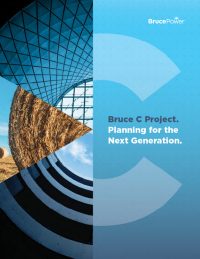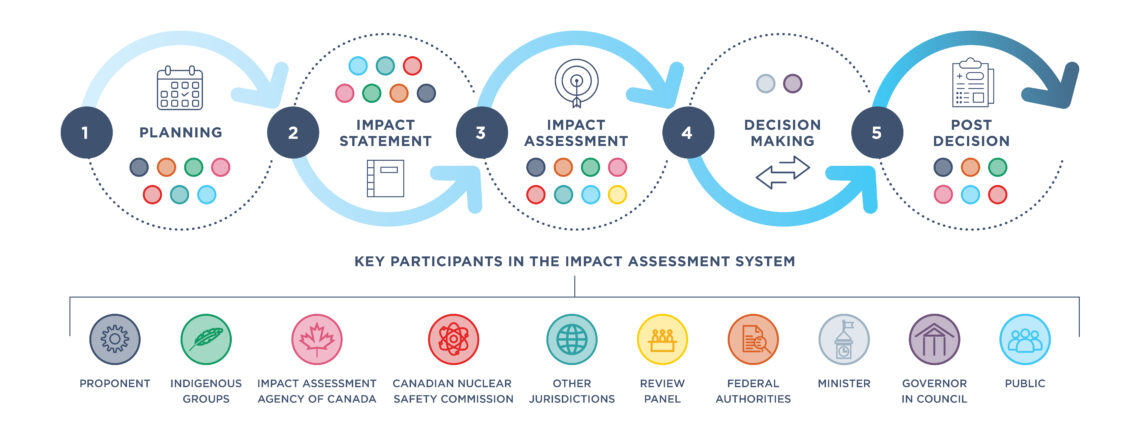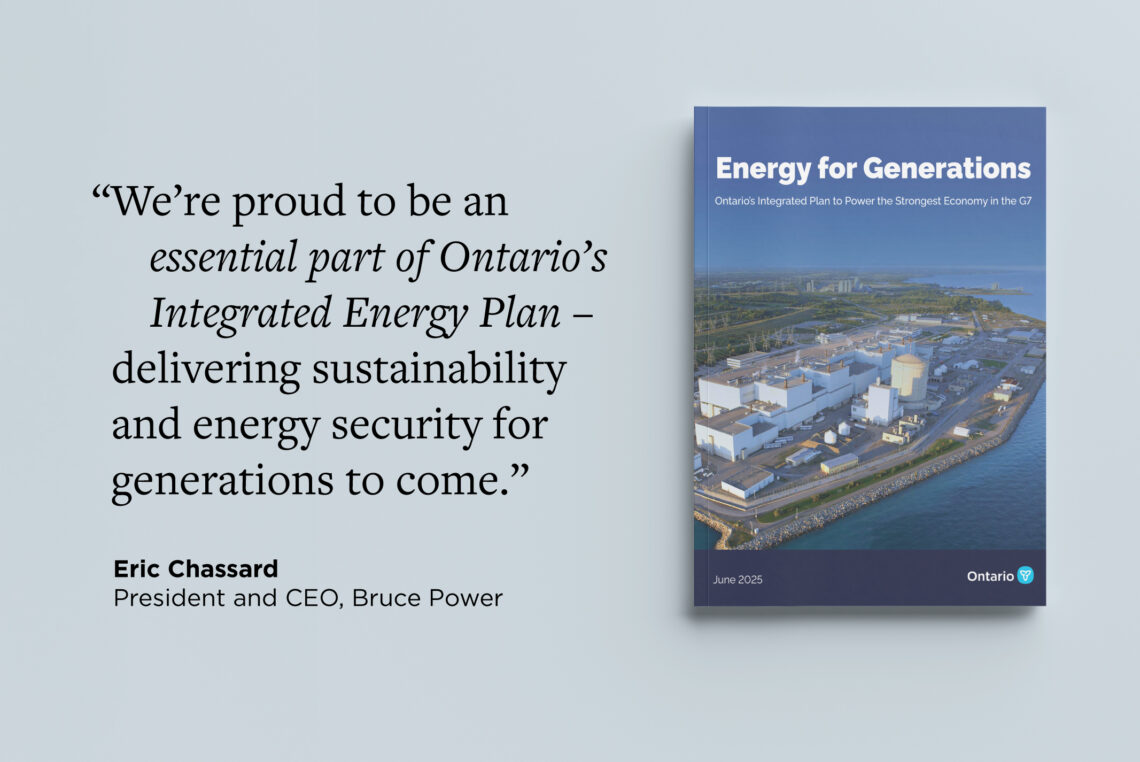Ontario needs nuclear power as it forecasts an unprecedented increase in electricity demand in the coming decades.
Through the ongoing Life-Extension Program, Bruce Power is securing a long-term supply of clean electricity to support the province’s growing energy needs.
As Ontario prepares for the future through its Powering Ontario’s Growth plan, Bruce Power has initiated a federal Impact Assessment (IA) for the Bruce C project. The project aims to create an option to build up to 4,800 megawatts of nuclear capacity at the Bruce Power site, located within the Territory of the Saugeen Ojibway Nation, in the Municipality of Kincardine, Ontario.
The Bruce C Project would create a valuable option for future electricity planning.

Learn more about the Bruce C Project. Planning for the Next Generation.
Impact Assessment Process
Major nuclear projects are subject to an integrated IA led by the Impact Assessment Agency of Canada (IAAC) alongside the Canadian Nuclear Safety Commission (CNSC), the nuclear lifecycle regulator.
An IA is a phased planning process spanning over multiple years, which involves Indigenous, municipal and public engagement, environmental and socioeconomic studies. If the Government of Canada determines that the project is of public interest, then a license to prepare site will be issued as part of the integrated assessment process. Should the province of Ontario and Bruce Power choose to proceed with a new build on Bruce Power’s existing site, additional permitting and licensing activities would be required.
The goal of an Impact Assessment is to help identify and assess the possible impacts of the project prior to any decision to build new nuclear and considers a wide range of factors including protecting the environment, ensuring respect for the rights of Indigenous Peoples and proposing measures to mitigate a project’s anticipated adverse effects.
This work completed throughout the Impact Assessment process is an important step to inform future electricity planning and will allow for timely implementation if a decision is made to advance a new build at Bruce Power.
Video source: Impact Assessment Agency of Canada
Project Updates
What's Happening Now?
The posting of the Bruce C Initial Project Description (IPD) on the Canadian Impact Assessment Registry marks the start of the Planning phase in the Impact Assessment.
During the Planning phase, the Bruce C Project team will:
a. Share information from the Bruce C Project IPD with Indigenous Nations and Communities, local municipalities and the public. Engage with these groups on valued components, which are aspects of environmental, health, social and economic conditions that are important to individuals or communities.
b. Continue socio-economic data collection and environmental field programs to establish existing conditions and support future studies and analysis.
c. Receive the Summary of Issues from the IAAC and form a response that outlines how we intend to address the issues raised. The Summary of Issues is a list of issues related to the project that participants see as relevant or of concern.
d. Receive the Tailored Impact Statement Guidelines from the IAAC which define the scope of the Impact Assessment. The Guidelines identify studies and information requirements that Bruce Power would need to include in the Impact Statement.
What's Next?
After the Planning phase, the Bruce C Project will progress to the Impact Statement phase. In the Impact Statement phase, the Bruce C Project team will:
a. Gather information through conducting studies and by engaging with Indigenous Nations and Communities, local municipalities, and the public as required in the Tailored Impact Statement Guidelines.
b. Analyze the potential positive and negative impacts of the project to inform the Impact Statement. This includes potential impacts to valued components, including information about the possible environmental, social, health and economic effects of the project, potential impacts on Indigenous peoples and their rights and proposed measures to mitigate adverse effects.
c. Compile the Impact Statement which will include:
- Baseline/existing conditions data
- All information, studies, and analysis of factors as required by the Tailored Impact Statement Guidelines
- Indigenous and community knowledge
- Identification of the potential adverse effects and impacts of the project and the extent to which they are adverse
Engagement
Bruce Power is advancing the IA process in a proactive, open and transparent manner to engage Indigenous Peoples, local communities, interested parties and the public early on.
We are committed to ensuring that interested parties remain informed and encourage you to visit our engagement platform to stay up to date on the Project and for opportunities to provide feedback.
Engagement Opportunities
Take an Early Engagement Survey
Tell us how you want to participate and let us know what questions you have about the Bruce C Project. A paper copy of the following survey is available at the Bruce Power Visitors’ Centre.
Learn More About Bruce Power
Come to the Bruce Power Visitors’ Centre or join a bus tour to learn more about safe, reliable and carbon-free nuclear energy and cancer-fighting medical isotopes.
Indigenous Engagement
The Bruce Power site is located within the Saugeen Ojibway Nation (SON) Territory, the shared treaty and traditional Territory of the Chippewas of Saugeen First Nation and the Chippewas of Nawash Unceded First Nation (Neyaashiinigmiing). Bruce Power is committed to proactive, open and transparent engagement with the SON, Historic Saugeen Métis (HSM) and Métis Nation of Ontario (MNO) as well as local communities.
Bruce Power remains dedicated to fostering a strong connection and meaningful engagement with Indigenous communities, which includes efforts to increase Indigenous employment, procurement, training and business opportunities. One example of this is the Gamzook’aamin aakoziwin partnership between the SON and Bruce Power to jointly market medical isotopes, which includes a revenue-sharing program providing a direct benefit to the community.
We are fully committed to engaging on concerns and opportunities raised by Indigenous Peoples and local communities as we progress through the Impact Assessment process. We will evolve these activities based on ongoing feedback and look forward to advancing this pre-development work important to Ontario’s clean energy future.
Bruce Power’s commitment to meaningful engagement with local Indigenous communities means we will continually seek opportunities to expand our relationship in a way that reflects the community’s unique needs and interests.
Frequently Asked Questions
In July 2023, Ontario’s Minister of Energy at the time, Hon. Todd Smith, announced at the Bruce Power site the province’s support to advance the long-term planning and consultation work required to explore nuclear expansion options on the Bruce Power site.
Additionally, over the next three decades, Ontario’s energy demand is forecasted to grow at a rapid pace. This is driven by anticipated population growth, attracting new industry to Ontario, and electrifying sectors that had previously relied on fossil fuel generation, such as electric vehicles and heavy industry.
Today, nuclear power supplies more than half of Ontario’s electricity. To maintain a clean, reliable grid for the future, nuclear power will play an important role in meeting the increased demand through nuclear refurbishments, power uprates, and creating the option for new nuclear generation.
Bruce Power is uniquely positioned for potential expansion, with decades of experience, a well-studied site, space for expansion, established Environmental Protection and ESG programs, strong community support and an experienced and professional workforce.
Currently, there is no decision to advance a new build.
Bruce Power’s focus is our Life-Extension Program and Project 2030 investments which will increase net peak output of our existing units and support essential energy output requirements outlined in the provincial government’s Powering Ontario’s Growth plan.
By completing the IA, the Bruce C Project will create a valuable option for future electricity planning.
A reactor technology has not been selected at this time. Bruce Power is preparing an Impact Assessment to evaluate the potential construction and operation of up to 4,800 megawatts of new nuclear generating capacity at the existing Bruce Power site.
The Impact Assessment will use a technology neutral approach, which involves the consideration of multiple technologies by forming a bounding case for the impact of new nuclear, known as a Plant Parameter Envelope (PPE). None of the individual reactor designs would have a greater impact than what is included in the PPE.
Bruce Power’s evaluation of prospective nuclear technologies will focus on the value for ratepayers, opportunities for Indigenous Nations and Communities, socioeconomic benefits for the Clean Energy Frontier region of Bruce, Grey and Huron counties, as well as a number of factors including safety, reliability and cost.
This website will be updated regularly with engagement opportunities and events. You may also subscribe to email updates from Bruce Power below.




